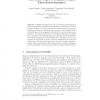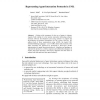24 search results - page 4 / 5 » Supporting UML Sequence Diagrams with a Processor Net Approa... |
UML
2001
Springer
13 years 12 months ago
2001
Springer
Sequence Diagrams (SDs) have proven useful for describing transaction-oriented systems, and can form a basis for creating statecharts. However, distributed embedded systems require...
DAGSTUHL
2003
13 years 9 months ago
2003
STAIRS is an approach to the compositional development of sequence diagrams supporting the specification of mandatory as well as potential behavior. In order to express the necess...
SQJ
2008
13 years 6 months ago
2008
A design pattern is realized in various forms depending on the context of the applications. There has been intensive research on detecting pattern instances in models and in implem...
TOPNOC
2008
13 years 7 months ago
2008
Message Sequence Charts (MSCs) are a well known language for specifying scenarios that describe how different actors (e.g., system components, people, or organizations) interact. M...
AOSE
2000
Springer
13 years 12 months ago
2000
Springer
Gaining wide acceptance for the use of agents in industry requires both relating it to the nearest antecedent technology (objectoriented software development) and using artifacts t...


